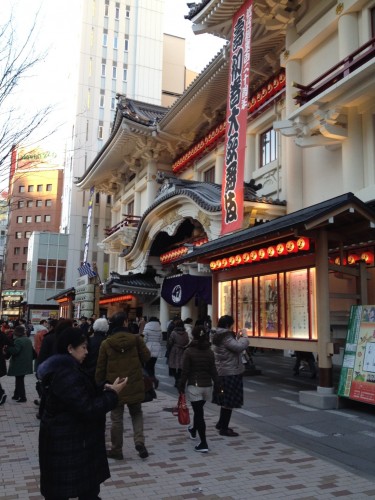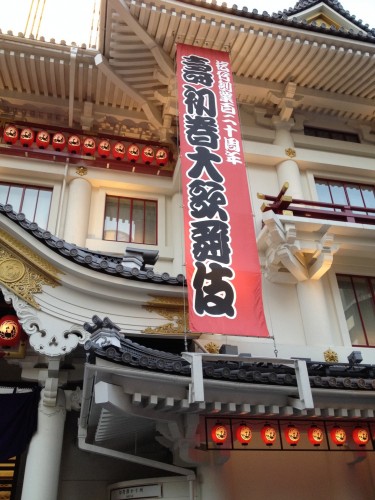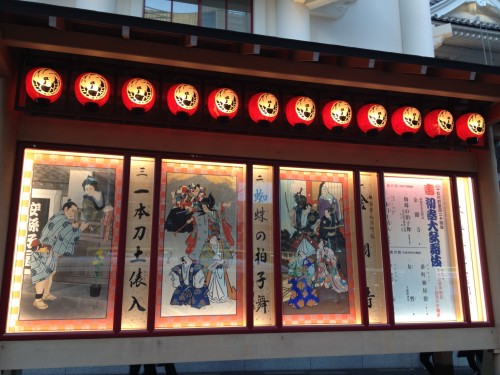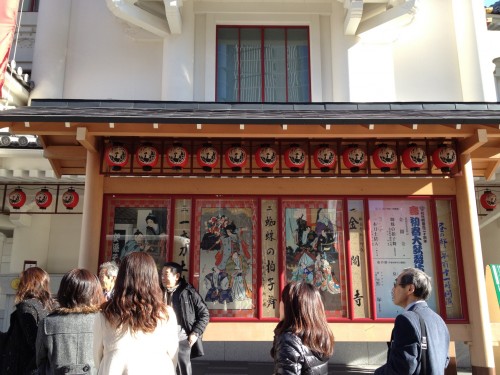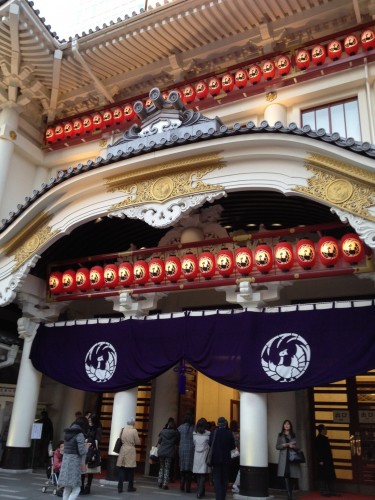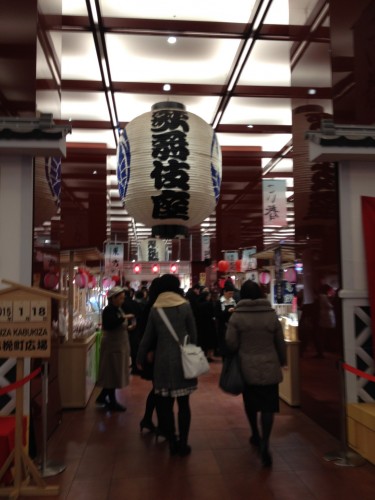One of the things unique to Japan and highly regarded as a cultural treasure is the art of Kabuki theatre. Nowadays not as fondly enjoyed by the Japanese population, as is surely true of things like Morris Dancing in England, Kabuki is still popular and important to the development of Japanese artistic traditions. There are not as many places to see Kabuki these days, though one is the Kabukiza in Ginza.
The Kabukiza shows around 6 performances in one day, of which you can choose to see some or all. The plays have a tendency to differ greatly from each other. One is about a mystery women who can transform into a spider and likes word games. One is about a failing sumo wrestler who learns instead to fight to protect his friends. There are many amazing stories told in very different ways, some more modern than others. Some with more modern language and less ornate costumes. Some taking artistic licence to an extreme, like Shibaraku, where the protagonist Kamakura Gongoro Kagemasa is depicted with larger than necessary clothing and red patterns in his make up to show his power and anger.
The sets and props are also something that could rival many West End stage performances. There is a scene in Tsuchigumo (Ground Spider) when the beautiful woman transforms into a spider on stage that to this day I can only assume was done using real magic, since it was so flawless, and its puppetry rivals those used in Warhorse.Every set is meticulously painted, and every costume takes note of even the slightest detail which cannot even be seen by most of the audience. There is a level of love and commitment to performance that makes Kabuki incredibly appealing.
For a non-Japanese speaker, there are English audio guides that you can rent which will explain the story, context and what each person is saying. However, Japanese audio guides are also available. Kabuki being a relatively old form of theatre is generally performed in the script it was written. Most Japanese people need help to understand the language used since many words and phrases have fallen out of common use. So, even those who speak Japanese fluently may need to rent a Japanese audio guide along with almost all the native speakers at the performances.
Kabuki performances can also be very long depending on how many you have elected to see. It is always a good idea to eat and drink beforehand -though don’t drink too much if you catch my drift. There are regular intervals between performances and set changes, but as we all know, buying food and drink from a venue is always expensive and the lines are always huge. It may also be a good idea to sleep well the night before you go to a performance.
Though Kabuki is a beautiful thing to watch, the plays imaginative and the actors captivating, there is always a large amount of people sleeping through some if not all of the performances. This is probably a combination of the cosy chairs and comfortable air-conditioning inside the venue, and the fact that Kabuki is to most Japanese people as Opera is to most Englishmen: long, confusing and sometimes obligatory. The same however can be said for visiting temples, someone who has never seen a Japanese temple will naturally be excited, where someone who walks past one everyday on the way to school may not see the appeal. Despite this, there is no denying the temple is stunning, as Kabuki is enthralling.
Kabuki may be one of the most stereotypical things we think about when we imagine Japan, but there is a reason it has stood the test of time. These stories are still relevant even in a modern society that no longer deal with Shogunates and magic spider people because they deal with human emotions. They give not only an insight into a time now past where warriors fought for the sake of chivalry, but also allow us to see this beautiful art form that may so easily have been forgotten to time. That is something anyone can appreciate.
Useful link: Kabuki Official Website
[cft format=0]



